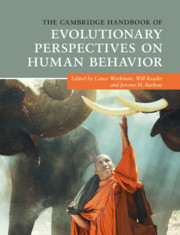Book contents
- The Cambridge Handbook of Evolutionary Perspectives on Human Behavior
- The Cambridge Handbook of Evolutionary Perspectives on Human Behavior
- Copyright page
- Dedication
- Contents
- Figures
- Tables
- Contributors
- Preface
- Acknowledgments
- Part I The Comparative Approach
- Part II Sociocultural Anthropology and Evolution
- 4 Eusociality in Humans
- 5 The Nature and Psychological Foundation of Social Universals
- 6 The Study of Culture and Evolution across Disciplines
- Part III Evolution and Neuroscience
- Part IV Group Living
- Part V Evolution and Cognition
- Part VI Evolution and Development
- Part VII Sexual Selection and Human Sex Differences
- Part VIII Abnormal Behavior and Evolutionary Psychopathology
- Part IX Applying Evolutionary Principles
- Part X Evolution and the Media
- Index
- References
4 - Eusociality in Humans
from Part II - Sociocultural Anthropology and Evolution
Published online by Cambridge University Press: 02 March 2020
- The Cambridge Handbook of Evolutionary Perspectives on Human Behavior
- The Cambridge Handbook of Evolutionary Perspectives on Human Behavior
- Copyright page
- Dedication
- Contents
- Figures
- Tables
- Contributors
- Preface
- Acknowledgments
- Part I The Comparative Approach
- Part II Sociocultural Anthropology and Evolution
- 4 Eusociality in Humans
- 5 The Nature and Psychological Foundation of Social Universals
- 6 The Study of Culture and Evolution across Disciplines
- Part III Evolution and Neuroscience
- Part IV Group Living
- Part V Evolution and Cognition
- Part VI Evolution and Development
- Part VII Sexual Selection and Human Sex Differences
- Part VIII Abnormal Behavior and Evolutionary Psychopathology
- Part IX Applying Evolutionary Principles
- Part X Evolution and the Media
- Index
- References
Summary
At one end of the eusociality continuum lie members of the genus Atta, the leafcutter ants. Across the American tropics, surrounded by the forests, grasslands, and pastures they harvest, these ants live in enormous subterranean nests, where they grow fungus. Older, bigger, “major” workers come and go along trails outside, where they forage for plants used as fungus substrates or specialize as soldiers in nest defense; younger, smaller, “minor” workers stay on the nest, where they tend fungus gardens and feed brood. At the core of every Atta colony is a single queen, who lays an average of 20 eggs every minute, or around 28,800 eggs every day, or more than 10,000,000 eggs every year. Over the course of her approximately 15-year lifespan, she may produce as many as 150–200 million young. Workers occasionally lay trophic eggs that are fed to the queen; and rarely, their rudimentary ovaries produce male larvae and pupae after a queen is lost.
- Type
- Chapter
- Information
- Publisher: Cambridge University PressPrint publication year: 2020
References
- 1
- Cited by

